Summary的写作技巧和常见句型
summary怎么写

1.英语中的SUMMARY怎么写具体格式步骤是什么英语中的SUMMARY撰写的具体格式步骤如下: 1、写之前,需要认真仔细地读几遍原文材料,让理解更深刻。
2、遵循原文的逻辑顺序,对重要部分的主题、标题、细节进行概括,全面清晰地表明原文信息。
3、给摘要起一个好标题,比如:可以采用文中的主题句。
4、尽量使用自己的话完成,不要引用原文的句子,篇幅控制在原文的三分之一或四分之一长。
5、写摘要时可以采用下列几种小技巧:(1)筛选1-2个例子。
(2)避免重复,删除细节,只保留主要观点。
(3)把长段描述压缩变成短小精悍的句子。
如下例:“His courage in battle might without exaggeration be called lion-like.” 可以概括为:”He was very brave in battle.” (5)你还可以使用词组代替整句或者从句。
(6)使用概括性的名词代替具体的词,比如:“She brought home several Chinese and English novels, a few copies of Time and Newsweek and some textbooks. She intended to read all of them during the winter vocation.” 可以概括为:”She brought home a lot of books to read during the vocation.” (7) 使用最短的连接词。
2.summary怎么写summary一般是英文作业中的总结或者摘要。
下面是我从meeloun教育网摘抄的summary写作方法,你可以看看,或许对你有用第一步:阅读 A.认真阅读给定的原文材料。
如果一遍不能理解,就多读两遍。
阅读次数越多,你对原文的理解就越深刻。
B.给summary起一个标题。
Summary的写作技巧和常见句型
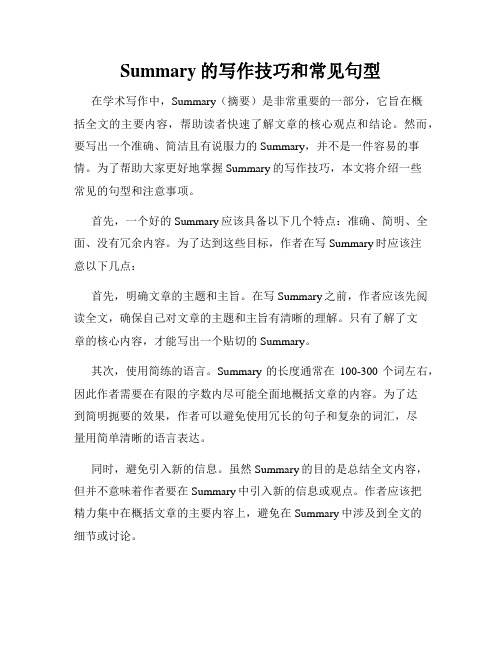
Summary的写作技巧和常见句型在学术写作中,Summary(摘要)是非常重要的一部分,它旨在概括全文的主要内容,帮助读者快速了解文章的核心观点和结论。
然而,要写出一个准确、简洁且有说服力的Summary,并不是一件容易的事情。
为了帮助大家更好地掌握Summary的写作技巧,本文将介绍一些常见的句型和注意事项。
首先,一个好的Summary应该具备以下几个特点:准确、简明、全面、没有冗余内容。
为了达到这些目标,作者在写Summary时应该注意以下几点:首先,明确文章的主题和主旨。
在写Summary之前,作者应该先阅读全文,确保自己对文章的主题和主旨有清晰的理解。
只有了解了文章的核心内容,才能写出一个贴切的Summary。
其次,使用简练的语言。
Summary的长度通常在100-300个词左右,因此作者需要在有限的字数内尽可能全面地概括文章的内容。
为了达到简明扼要的效果,作者可以避免使用冗长的句子和复杂的词汇,尽量用简单清晰的语言表达。
同时,避免引入新的信息。
虽然Summary的目的是总结全文内容,但并不意味着作者要在Summary中引入新的信息或观点。
作者应该把精力集中在概括文章的主要内容上,避免在Summary中涉及到全文的细节或讨论。
此外,注意使用一些常见的句型来连接句子,使Summary更加连贯和流畅。
以下是一些常用的句型:1. Overall, the article/book/paper gives a detailed analysis of...2. In conclusion, the author argues that...3. The study provides valuable insights into...4. From the findings/results, it can be inferred that...5. The research sheds light on the importance of...6. In summary, the main idea of the article is...总之,写Summary并不是难事,关键在于把握好文章的主题和主要内容,使用简练清晰的语言进行概括。
summary写作技巧

summary写作技巧
1、注重概括比重:综述时要将写作的最重要的意思概括出来,这要求
理解全文的大意,再进行概括。
2、运用核心词汇:summary写作时很重要的一点就是用对的词,尽
量用文章中出现的主要词汇,如果不熟悉就可用同义词替换。
3、选择合适的句式:summary最重要的就是要简洁明了,句式要尽
量简短,要能概括主要内容,避免不必要的细节和观点,结尾可以用比喻,让原文的重点跃然纸上。
4、把握篇章结构:理解文章的篇章结构对summary的写作至关重要,熟悉文稿的主题和论述方法后,才可以突出主要论点,把握文章的脉络。
5、多多练习:summary写作需要掌握正确的技巧,通过多练习,不
断积累实际经验,熟能生巧,并能熟练应用。
SUMMARY 格式及模板

SUMMARY的最常见格式是总分总.开头笼统的介绍以下,给读者一个大概的概念,然后分段总结这个你好总结的东东的各个方面。
关键看你要写多少字,概括的是什么,再决定中间这部分是分小段还是一大段内,分开概括.最后就是总结了。
有的时候你会感觉总结和开篇介绍很相似,确实是这样,但是总结只是更近一步的对这个事物进行了概括。
这个时候,读者就应该对你所总结的事物有一种整体上的认识了。
一段好的摘要必须包括main idea和supporting details.main idea说明文章的主旨,作者主要诉说的故事是关于什么?supporting details则帮助发展或说明主题。
如何写英文摘要英文摘要如何写如何写摘要一、概述文章摘要是对所写文章主要内容的精炼概括。
美国人称摘要为“Abstract”,而英国人则喜欢称其为“Summary"。
通常国际刊物要求所要刊登的文章字数,包括摘要部分不超过1万字。
而对文章摘要部分的字数要求则更少。
因此,写摘要时,应用最为简练的语言来表达论文之精华。
论文摘要的重点应放在所研究的成果和结论上。
国际会议要求的论文摘要的字数不等,一般为200字-500字。
而国际刊物要求所刊登的论文摘要的字数通常是100字-200字。
摘要的位置一般放在一篇文章的最前面,内容上涵盖全文,并直接点明全旨。
语言上要求尽量简炼.摘要通常多采用第三人称撰写.科学书籍、论文和学术报告一般都附有内容摘要,这样可以节省读者的时间,使他们不必读完整个文章就能够了解它的主要内容.书籍摘要,一般放在封二或封三;论文和学术报告的摘要,一般放在正文前面。
摘要应做到简明扼要,切题,能独立成文,使读者能准确地了解书籍的要义.写摘要时,最好用第三人称的完整的陈述句,文长一般不超过200个词。
摘要分陈述性的(Descriptive)和资料性的(Informational)两类。
陈述性摘要只陈述书籍或文章的主题,不介绍内容。
资料性的摘要除了介绍主题外,还应介绍文章的要点和各个要点的主要内容。
英文写作(论文)中Summary常用句式

我只找到这些了,你最好还是去学校的图书馆找本写作书书看看吧,里面应该有很多简短的summary范文。
字数最好不要太多,150~200个单词就行了,大概占原文篇幅的1/4。
Summary 常用句式1.This article/ passage mainly tells (a story) about……2.This passage mainly deals with/discusses/explores/……3.In this passage (about ……), the author ……4.In this passage about ……, the author ……5.The author began the essay/ passage by telling/ presenting……6.First/Firstly/ In the beginning/In the first part, the author argues/ explains/ mentions/ states/ points out (that)……7.Secondly/ Next/ Further on/ Then/ In the next part/ In the main part, the author goes on with……8.Finally/ As a conclusion/, the author concludes/ adds/ stresses that……9.Finally, the author summarizes that ……二、常见句型1)This paper deals with..2)This article focuses on the topics of (that,having,etc).3)This essay presents knowledge that...4)This thesis discusses...5)This thesis analyzes...6)This paper provides an overview of...7)This paper elaborates on ..8)This article gives an overview of...9)This article compares...and summarizes key findings.10)This paper includes discussions concerning...11)This paper presents up12)This article covers the role of chemicals in...13)This paper addresses important topics including...14)This paper touches upon...15)This paper strongly emphasizes..17)This article not only describes...but also suggests...18)This paper considers...19)This paper provides a method of ...20)This paper introduces an applicable procedure to analyze...21)This paper offers the latest information regarding...22)This paper is devoted to examining the role of...23)This article explores...24)This paper expresses views on...25)This paper reflects the state of the art in...26)This paper explains the procedures for...¬27)This paper develops the theory of ..28)This article reviews the techniques used in...29)This paper investigates the techniques and procedures to...30)This article is about...31)This essay is related to ...32)This paper concerns...33)This paper gives an account of ...34)This article tells of...35)This paper tries to describe...36)This paper provides an analysis of ...37)This paper reports the latest information on ..38)The author of this article reviews..39)The writer of this paper discusses...40)The writer of this essay tries to explore...41)The aim of this paper is to determine..42)The purpose of this article is to review...43)The objective of this paper is to explore...破题用语,一般有:①The author of this article reviews (or: discusses, describes, summarizes, examines) something……②This article reviews (or:reports,tells of,is about,concerns)something…….③This article has been prepared (or:designed,written)…….④The purpose of this article is to determine something…….⑤The problem of something is discussed …….结论和建议,一般有以下几种写法:①The author suggests (recommends,concludes)that…….②This article shows that…….③It is suggested that…….④The author's suggestion (or:conclusion )is that ……⑤The author finds it necessary to …….Useful Transitions and Transitional Phrases Introduction to a Topic as for, concerning, with regard to, with respect to, in terms ofTo Summarize in all, in a word, in brief, briefly, in other words, in short, in summary, that is, finally, generally, in conclusion, on the whole, therefore, to sum up, to conclude, and so, this shows, thus we seeTo Compare by comparison, here again, in the same way, in a similar manner, likewise, similarly, so too, as, also, equally, accordingly, moreover, as well, andTo Contrast conversely, however, instead (of), in spite of that, anyhow, on the contrary, on the other hand, otherwise, rather than, still, yet, nevertheless, in contrast, notwithstanding, in spite of this, although, but, despite, even thoughTo Show Cause and Effect accordingly, as a consequence, as a result, consequently, for this reason, hence, it follows that, so/so that, then, therefore, thus, thereuponTo Explain actually, admittedly, because, certainly, for example, in fact, indeed, really of course, since, that is, for instance, namely, specifically, such as, to illustrate, in particular, in this manner, thusTo Show Conviction after all, at least, at the same time, apparently, even so, evidently, certainly, conceivably, conclusively, doubtless, no doubt, perhaps, possibly, presumably, probably, surely, undoubtedlyTo Show Various Conditions in this event, in these circumstances, this (that) being so, provided that,in spite of, none/nevertheless, at the same time, even if, if, unless, otherwise, although, even though, though, despiteTo Add Information add to this, again, also, besides, equally, further, furthermore, in addition, moreover, once more, then too, too, yet again, yet another, and, as well, beyond that, even, next, similarlyTo Show Chronological Order after that, afterwards, later, shortly, subsequently, concurrently, in the meantime, in the meanwhile, now, simultaneously, when/while/was, first, second, etc., formerly, earlier, previously, before that, then, already, at last, at length, by that time, finally, during, immediately, next, soon, still, in the interim, presently, at the same time, in the end, temporarily, thereafterTo Show Concession admittedly, after all, all the same, at any rate, granted, however, in any case, in spite of, it is true that, nevertheless, obviously, of course, still, to be sureLocation above, below, beyond, farther, further, here, nearby, opposite, there, to t。
有关summary的写作技巧
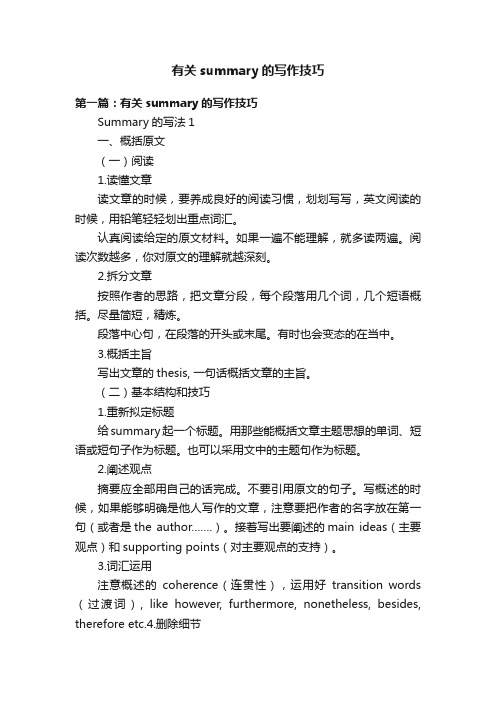
有关summary的写作技巧第一篇:有关summary的写作技巧Summary的写法1一、概括原文(一)阅读1.读懂文章读文章的时候,要养成良好的阅读习惯,划划写写,英文阅读的时候,用铅笔轻轻划出重点词汇。
认真阅读给定的原文材料。
如果一遍不能理解,就多读两遍。
阅读次数越多,你对原文的理解就越深刻。
2.拆分文章按照作者的思路,把文章分段,每个段落用几个词,几个短语概括。
尽量简短,精炼。
段落中心句,在段落的开头或末尾。
有时也会变态的在当中。
3.概括主旨写出文章的thesis, 一句话概括文章的主旨。
(二)基本结构和技巧1.重新拟定标题给summary起一个标题。
用那些能概括文章主题思想的单词、短语或短句子作为标题。
也可以采用文中的主题句作为标题。
2.阐述观点摘要应全部用自己的话完成。
不要引用原文的句子。
写概述的时候,如果能够明确是他人写作的文章,注意要把作者的名字放在第一句(或者是the author…….)。
接着写出要阐述的main ideas(主要观点)和supporting points(对主要观点的支持)。
3.词汇运用注意概述的coherence(连贯性),运用好transition words (过渡词), like however, furthermore, nonetheless, besides, therefore etc.4.删除细节只保留主要观点。
5.选择一至两个有代表性的例子原文中可能包括5个或更多的例子,你只需从中筛选一至二个例子。
6.把长句变成短句,把长段的描述变成短小、简单的句子。
“ He was hard up for money and was being pressed by his creditor.” 可以概括为:“He was in financial difficulties.”“His courage in battle might without exaggeration be called lion-like.” 可以概括为:”He was very brave in battle.”“He was hard up for mone y and was being pressed by his creditor.” 可以概括为:“He was in financial difficulties.”6)你还可以使用词组代替整句或者从句。
Summary的写作技巧和常见句型

Summary的写作技巧和常见句型2.阐述观点摘要应全部用自己的话完成。
不要引用原文的句子。
写概述的时候,如果能够明确是他人写作的文章,注意要把作者的名字放在第一句(或者是the author…….)。
接着写出要阐述的main ideas(主要观点)和supporting points(对主要观点的支持)。
3.词汇运用注意概述的coherence(连贯性),运用好transition words(过渡词), like however, furthermore, nonetheless, besides, therefore etc.4.删除细节只保留主要观点。
5.选择一至两个有代表性的例子原文中可能包括5个或更多的例子,你只需从中筛选一至二个例子。
6.把长句变成短句,把长段的描述变成短小、简单的句子。
“He was hard up for money and was being pressed by his creditor.”可以概括为:“He was in financial difficulties.”“His courage in battle might without exaggeration be called lion-like.”可以概括为:”He was very brave in battle.”“He was hard up for money and was being pressed by his creditor.”可以概括为:“He was in financial difficulties.”6) 你还可以使用词组代替整句或者从句。
请看下面的例子:“Beautiful mountains like Mount Tai, Lushan Mountain, and Mount Huang, were visited by only a few people in the past. Today, better wages, holidays with pay, new hotels on these mountains, and better train and bus services, have brought them within reach of many who never thought of visiting them ten years ago.”可以概括为:”Beautiful mountains like Mount Tai, once visited by only a few people, are today accessible to many, thanks to better wages, paid holidays, new hotels and better transportation services.”7) 使用概括性的名词代替具体的词,比如:“She brought home several Chinese and English novels, a few copies of Time and Newsweek and some textbooks. She intended to read all of them during the winter vocation.”可以概括为:”She brought home a lot of books to read during the vocation.”8)使用最短的连接词。
SUMMARY 格式及模板

SUMMARY的最常见格式是总分总。
开头笼统的介绍以下,给读者一个大概的概念,然后分段总结这个你好总结的东东的各个方面.关键看你要写多少字,概括的是什么,再决定中间这部分是分小段还是一大段内,分开概括.最后就是总结了。
有的时候你会感觉总结和开篇介绍很相似,确实是这样,但是总结只是更近一步的对这个事物进行了概括.这个时候,读者就应该对你所总结的事物有一种整体上的认识了.一段好的摘要必须包括main idea和supporting details。
main idea说明文章的主旨,作者主要诉说的故事是关于什么?supporting details则帮助发展或说明主题。
如何写英文摘要英文摘要如何写如何写摘要一、概述文章摘要是对所写文章主要内容的精炼概括。
美国人称摘要为“Abstract”,而英国人则喜欢称其为“Summary”。
通常国际刊物要求所要刊登的文章字数,包括摘要部分不超过1万字。
而对文章摘要部分的字数要求则更少。
因此,写摘要时,应用最为简练的语言来表达论文之精华。
论文摘要的重点应放在所研究的成果和结论上.国际会议要求的论文摘要的字数不等,一般为200字—500字。
而国际刊物要求所刊登的论文摘要的字数通常是100字—200字.摘要的位置一般放在一篇文章的最前面,内容上涵盖全文,并直接点明全旨.语言上要求尽量简炼。
摘要通常多采用第三人称撰写。
科学书籍、论文和学术报告一般都附有内容摘要,这样可以节省读者的时间,使他们不必读完整个文章就能够了解它的主要内容。
书籍摘要,一般放在封二或封三;论文和学术报告的摘要,一般放在正文前面.摘要应做到简明扼要,切题,能独立成文,使读者能准确地了解书籍的要义。
写摘要时,最好用第三人称的完整的陈述句,文长一般不超过200个词.摘要分陈述性的(Descriptive)和资料性的(Informational)两类。
陈述性摘要只陈述书籍或文章的主题,不介绍内容.资料性的摘要除了介绍主题外,还应介绍文章的要点和各个要点的主要内容。
英语summary万能模板
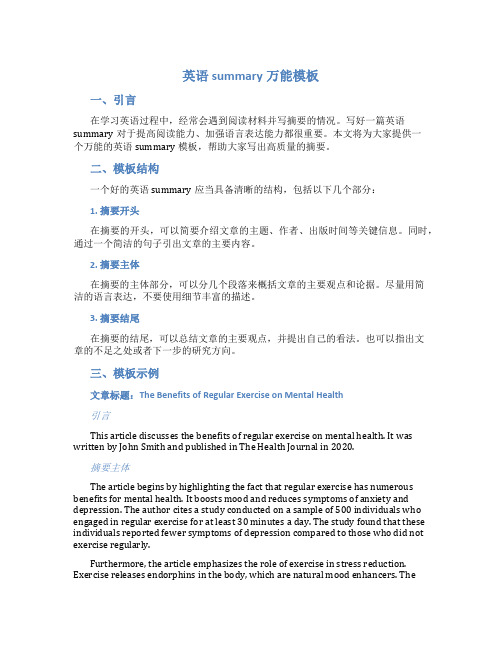
英语summary万能模板一、引言在学习英语过程中,经常会遇到阅读材料并写摘要的情况。
写好一篇英语summary对于提高阅读能力、加强语言表达能力都很重要。
本文将为大家提供一个万能的英语summary模板,帮助大家写出高质量的摘要。
二、模板结构一个好的英语summary应当具备清晰的结构,包括以下几个部分:1. 摘要开头在摘要的开头,可以简要介绍文章的主题、作者、出版时间等关键信息。
同时,通过一个简洁的句子引出文章的主要内容。
2. 摘要主体在摘要的主体部分,可以分几个段落来概括文章的主要观点和论据。
尽量用简洁的语言表达,不要使用细节丰富的描述。
3. 摘要结尾在摘要的结尾,可以总结文章的主要观点,并提出自己的看法。
也可以指出文章的不足之处或者下一步的研究方向。
三、模板示例文章标题:The Benefits of Regular Exercise on Mental Health引言This article discusses the benefits of regular exercise on mental health. It was written by John Smith and published in The Health Journal in 2020.摘要主体The article begins by highlighting the fact that regular exercise has numerous benefits for mental health. It boosts mood and reduces symptoms of anxiety and depression. The author cites a study conducted on a sample of 500 individuals who engaged in regular exercise for at least 30 minutes a day. The study found that these individuals reported fewer symptoms of depression compared to those who did not exercise regularly.Furthermore, the article emphasizes the role of exercise in stress reduction. Exercise releases endorphins in the body, which are natural mood enhancers. Therelease of endorphins during exercise helps to reduce stress and promote a sense of well-being. The author also explains that exercise can improve cognitive function and boost memory and concentration.The article also discusses the impact of exercise on sleep quality. Regular exercise helps regulate sleep patterns and can improve the quality of sleep. The author cites a study conducted on individuals with insomnia, where exercise was found to be an effective intervention in improving sleep quality.摘要结尾In conclusion, the article highlights the positive effects of regular exercise on mental health. It provides evidence that exercise can improve mood, reduce symptoms of anxiety and depression, reduce stress, improve cognitive function, and enhance sleep quality. It is recommended that individuals incorporate regular exercise into their daily routines to reap these mental health benefits.四、总结通过使用以上的万能summary模板,我们可以更加轻松地写出高质量的英语摘要。
(完整word版)SUMMARY 格式及模板

SUMMARY的最常见格式是总分总.开头笼统的介绍以下,给读者一个大概的概念,然后分段总结这个你好总结的东东的各个方面。
关键看你要写多少字,概括的是什么,再决定中间这部分是分小段还是一大段内,分开概括。
最后就是总结了。
有的时候你会感觉总结和开篇介绍很相似,确实是这样,但是总结只是更近一步的对这个事物进行了概括.这个时候,读者就应该对你所总结的事物有一种整体上的认识了.一段好的摘要必须包括main idea和supporting details.main idea说明文章的主旨,作者主要诉说的故事是关于什么?supporting details则帮助发展或说明主题。
如何写英文摘要英文摘要如何写如何写摘要一、概述文章摘要是对所写文章主要内容的精炼概括。
美国人称摘要为“Abstract”,而英国人则喜欢称其为“Summary”。
通常国际刊物要求所要刊登的文章字数,包括摘要部分不超过1万字.而对文章摘要部分的字数要求则更少。
因此,写摘要时,应用最为简练的语言来表达论文之精华。
论文摘要的重点应放在所研究的成果和结论上。
国际会议要求的论文摘要的字数不等,一般为200字—500字。
而国际刊物要求所刊登的论文摘要的字数通常是100字-200字。
摘要的位置一般放在一篇文章的最前面,内容上涵盖全文,并直接点明全旨.语言上要求尽量简炼.摘要通常多采用第三人称撰写.科学书籍、论文和学术报告一般都附有内容摘要,这样可以节省读者的时间,使他们不必读完整个文章就能够了解它的主要内容.书籍摘要,一般放在封二或封三;论文和学术报告的摘要,一般放在正文前面。
摘要应做到简明扼要,切题,能独立成文,使读者能准确地了解书籍的要义。
写摘要时,最好用第三人称的完整的陈述句,文长一般不超过200个词.摘要分陈述性的(Descriptive)和资料性的(Informational)两类。
陈述性摘要只陈述书籍或文章的主题,不介绍内容。
资料性的摘要除了介绍主题外,还应介绍文章的要点和各个要点的主要内容. 它可以包括三个组成部分①点明主题,解析文章或书籍的目的或意图;②介绍主要内容,使读者迅速了解文章或书籍的概貌;③提出结论或建议,以供读者参考.二、常见句型1)This paper deals with.。
Summary的写作技巧和常见句型
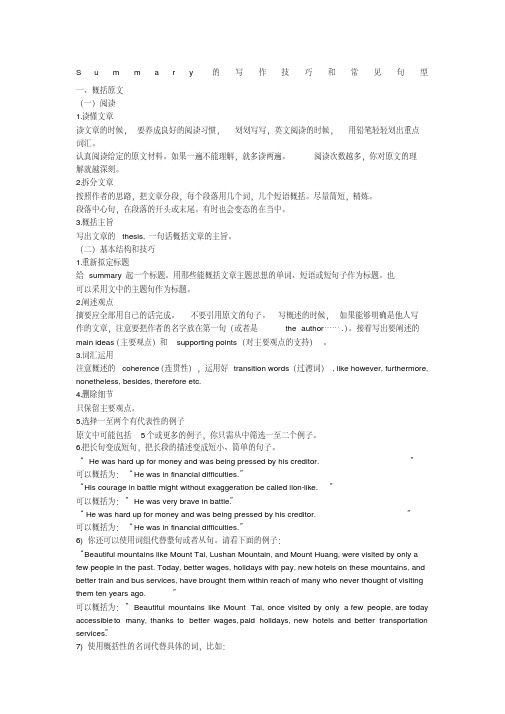
S u m m a r y的写作技巧和常见句型一、概括原文(一)阅读1.读懂文章读文章的时候,要养成良好的阅读习惯,划划写写,英文阅读的时候,用铅笔轻轻划出重点词汇。
认真阅读给定的原文材料。
如果一遍不能理解,就多读两遍。
阅读次数越多,你对原文的理解就越深刻。
2.拆分文章按照作者的思路,把文章分段,每个段落用几个词,几个短语概括。
尽量简短,精炼。
段落中心句,在段落的开头或末尾。
有时也会变态的在当中。
3.概括主旨写出文章的thesis, 一句话概括文章的主旨。
(二)基本结构和技巧1.重新拟定标题给summary起一个标题。
用那些能概括文章主题思想的单词、短语或短句子作为标题。
也可以采用文中的主题句作为标题。
2.阐述观点摘要应全部用自己的话完成。
不要引用原文的句子。
写概述的时候,如果能够明确是他人写作的文章,注意要把作者的名字放在第一句(或者是the author…….)。
接着写出要阐述的main ideas(主要观点)和supporting points(对主要观点的支持)。
3.词汇运用注意概述的coherence(连贯性),运用好transition words(过渡词), like however, furthermore, nonetheless, besides, therefore etc.4.删除细节只保留主要观点。
5.选择一至两个有代表性的例子原文中可能包括5个或更多的例子,你只需从中筛选一至二个例子。
6.把长句变成短句,把长段的描述变成短小、简单的句子。
“He was hard up for money and was being pressed by his creditor.”可以概括为:“He was in financial difficulties.”“His courage in battle might without exaggeration be called lion-like.” 可以概括为:”He was very brave in battle.”“He was hard up for money and was being pressed by his creditor.” 可以概括为:“He was in financial difficulties.”6) 你还可以使用词组代替整句或者从句。
高考英语summary写作【终极版】

写摘要时可以采用下列几种小技巧:1) 删除细节。
只保留主要观点。
2) 避免重复。
在原文中,为了强调某个主题,可能会重复论证说明。
但是这在摘要中是不能使用的。
应该删除那些突出强调的重述句。
3) 删除具体例子。
不过,阅读材料本身是由几个具体例子构成的,如阅读材料是谈西方种种节日的,如删除具体例子,则概括很难达到30个词,那就选择一至两个例子(即一两个主要节日)。
注:原文中可能包括5个或更多的例子,你只需从中筛选一至二个例子。
4) 使用概括性的名词代替具体的词,比如:“She brought home several Chinese and English novels, a few copies of Time and Newsweek and some textbooks. She intended to read all of them during the winter vocation.”可以概括为:“She brought home a lot of books to read during the vocation.”5) 把文章的对话或直接引语(的要点)改成间接引语叙述。
6) 把长段的描述变成短小、简单的句子。
如果材料中描述某人或某事用了十个句子,那么你只要把它们变成一两句即可。
7) 压缩长的句子。
如下列两例:“His courage in battle might without exaggeration be called lion-like.”可以概括为:“He was very brave in battle.”“He was hard up for money and was being pressed by his creditor.”可以概括为:“He was in financial difficulties.”8) 你还可以使用词组代替整句或者从句。
“Beautiful mountains like Mount Tai, Lushan Mountain, and Mount Huang, were visited by only a few people in the past. Today, better wages, holidays with pay, new hotels on these mountains, and better train and bus services, have brought them within reach of many who never thought of visiting them ten years ago.”可以概括为:”Beautiful mountains like Mount Tai, once visited by only a few people, are today accessible to many, thanks to better wages, paid holidays, new hotels and better transportation services.”9) 文章中的第一人称说的话通常在摘要中转换成第三人称,从而把大段的对白简化,比如:Kate looked at Paul disapprovingly: You use much too much salt on your food, Paul —it’s not good for you!” Paul put down his knife and frowned:”Why on earth not! If you didn’t have salt on your food it would taste awful… like eating cardboard or sand… just imagine bread without saltin it, or potatoes or pasta cooked without salt!” Kate was patient. She didn’t want to quarrel with Paul. She wanted to persuade him. She said firmly:”But too much salt is bad for you. It cause high blood pressure and latter on, heart-attacks. It also disguises the taste of food, the real tastes which are much more subtle than salt, and which we have lost the sensitivity to appreciate any more.”可以用第三人称概括为:Kate suggested to Paul that he should eat less salt. She thought that eating too much salt would do hard to Paul’s health and that it could reduce the real tastes of food. But Paul disagreed. He said that food without salt would be tasteless.II.练习篇---- 学以致用1,Then, you can think of away to make both sides happy. Here are some tips1)Make time to talk. You could talk about your school life and your plans for the future.2)..Keep a diary. It can help you understand more about yourself and your feelings.3). Show your parents you are growing up. Wash your own clothes and help around the house.Summary: There are some tips for children to follow so that they can get on well with their parents.2. Sometimes, kids don’t think their parents are fair to them. When you want to dress in a modern way, your mum doesn’t like you to wear a mini-skirt. When you are making phone calls to friends, they ask whether you’re speaking to a boy or a girl.Summary: It is quite natural that we children look at the same problem differently from our parents.3. Kate looked at Paul disapprovingly, “You use too much salt on your food, Paul. It’s not at all good for you!” Paul put downhis knife and frowned, “Why on earth not! If you didn’t have salt on you r food it would taste awful…like eating wood or sand…just imagine bread without salt in it!”Summary: Kate suggested that Paul should eat less salt. But Paul disagreed. He said that food without salt would be tasteless.4. She brought home several Chinese and English novels,a few copies of Time and Newsweek, and some textbooks. She intended to read all of them during the winter vacation. Summary:She brought home a lot of books and magazines to read during the vacation.Ⅲ.Task2: find out how to summarize the whole passage 段意合并法 (说明文、应用文)第一步, 通读全文, 领略大意;第二步,小结每一段的大意;第三步, 根据每一段的大意以及作者的侧重点, 综合归纳全文的大意.对于说明性或描述性短文,可以用概括性文字说明某一现象。
完整word版英文Summary写作方法范例及常用句式word文档良心出品
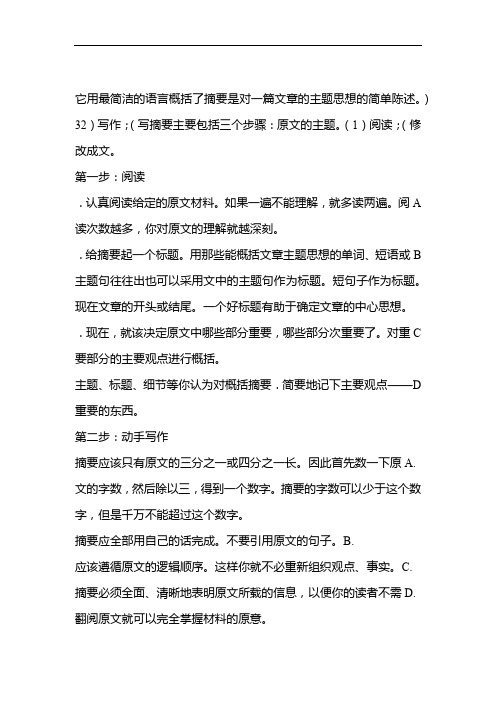
它用最简洁的语言概括了摘要是对一篇文章的主题思想的简单陈述。
)32)写作;(写摘要主要包括三个步骤:原文的主题。
(1)阅读;(修改成文。
第一步:阅读.认真阅读给定的原文材料。
如果一遍不能理解,就多读两遍。
阅A 读次数越多,你对原文的理解就越深刻。
.给摘要起一个标题。
用那些能概括文章主题思想的单词、短语或B 主题句往往出也可以采用文中的主题句作为标题。
短句子作为标题。
现在文章的开头或结尾。
一个好标题有助于确定文章的中心思想。
.现在,就该决定原文中哪些部分重要,哪些部分次重要了。
对重C 要部分的主要观点进行概括。
主题、标题、细节等你认为对概括摘要.简要地记下主要观点——D 重要的东西。
第二步:动手写作摘要应该只有原文的三分之一或四分之一长。
因此首先数一下原A. 文的字数,然后除以三,得到一个数字。
摘要的字数可以少于这个数字,但是千万不能超过这个数字。
摘要应全部用自己的话完成。
不要引用原文的句子。
B.应该遵循原文的逻辑顺序。
这样你就不必重新组织观点、事实。
C.摘要必须全面、清晰地表明原文所载的信息,以便你的读者不需D. 翻阅原文就可以完全掌握材料的原意。
/ 119写摘要时可以采用下列几种小技巧:E.删除细节。
只保留主要观点。
1)个或更多的例子,你只需52) 选择一至两个例子。
原文中可能包括从中筛选一至二个例子。
把长段的描述变成短小、简单的句子。
如果材料中描述某人或某3) 事用了十个句子,那么你只要把它们变成一两句即可。
可能会重复论证说明。
为了强调某个主题,避免重复。
在原文中,4) 但是这在摘要中是不能使用的。
应该删除那些突出强调的重述句。
压缩长的句子。
如下列两例:5)like.”“His courage in battle might without exaggeration be called lion-”He was very brave in battle.”可以概括为:“He was hard up for money and was being pressed by his creditor.”“He was in financial difficulties.”可以概括为:你还可以使用词组代替整句或者从句。
英文summary的格式
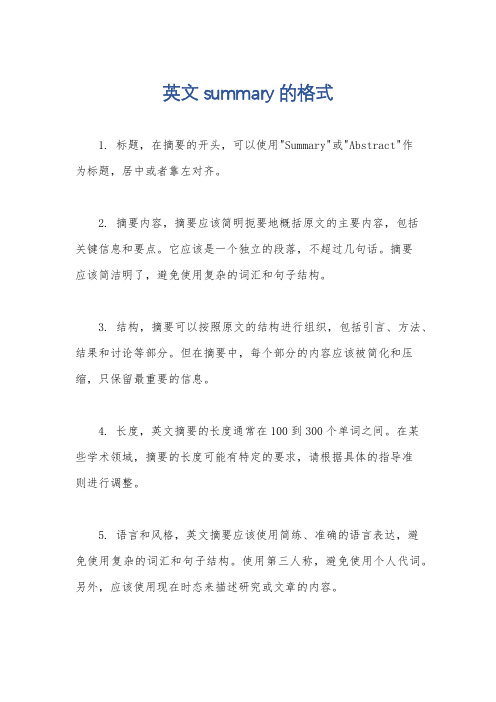
英文summary的格式
1. 标题,在摘要的开头,可以使用"Summary"或"Abstract"作
为标题,居中或者靠左对齐。
2. 摘要内容,摘要应该简明扼要地概括原文的主要内容,包括
关键信息和要点。
它应该是一个独立的段落,不超过几句话。
摘要
应该简洁明了,避免使用复杂的词汇和句子结构。
3. 结构,摘要可以按照原文的结构进行组织,包括引言、方法、结果和讨论等部分。
但在摘要中,每个部分的内容应该被简化和压缩,只保留最重要的信息。
4. 长度,英文摘要的长度通常在100到300个单词之间。
在某
些学术领域,摘要的长度可能有特定的要求,请根据具体的指导准
则进行调整。
5. 语言和风格,英文摘要应该使用简练、准确的语言表达,避
免使用复杂的词汇和句子结构。
使用第三人称,避免使用个人代词。
另外,应该使用现在时态来描述研究或文章的内容。
6. 关键词,在摘要的末尾,可以列出几个关键词,用于描述文章的主题和内容。
这些关键词应该与原文的主题和关键词相关联。
总之,英文摘要的格式应该简洁明了,突出文章的核心内容和要点,同时符合学术规范和要求。
具体的格式可以根据不同的出版物或学术机构的要求进行调整。
Summary的写作技巧和常见句型
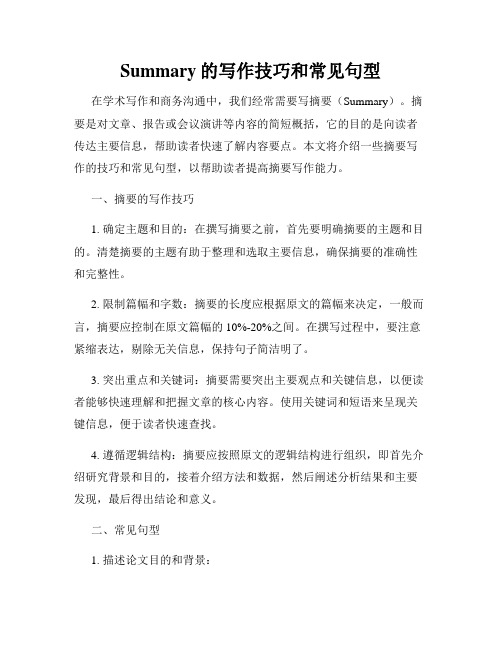
Summary的写作技巧和常见句型在学术写作和商务沟通中,我们经常需要写摘要(Summary)。
摘要是对文章、报告或会议演讲等内容的简短概括,它的目的是向读者传达主要信息,帮助读者快速了解内容要点。
本文将介绍一些摘要写作的技巧和常见句型,以帮助读者提高摘要写作能力。
一、摘要的写作技巧1. 确定主题和目的:在撰写摘要之前,首先要明确摘要的主题和目的。
清楚摘要的主题有助于整理和选取主要信息,确保摘要的准确性和完整性。
2. 限制篇幅和字数:摘要的长度应根据原文的篇幅来决定,一般而言,摘要应控制在原文篇幅的10%-20%之间。
在撰写过程中,要注意紧缩表达,剔除无关信息,保持句子简洁明了。
3. 突出重点和关键词:摘要需要突出主要观点和关键信息,以便读者能够快速理解和把握文章的核心内容。
使用关键词和短语来呈现关键信息,便于读者快速查找。
4. 遵循逻辑结构:摘要应按照原文的逻辑结构进行组织,即首先介绍研究背景和目的,接着介绍方法和数据,然后阐述分析结果和主要发现,最后得出结论和意义。
二、常见句型1. 描述论文目的和背景:本文旨在研究/探讨/分析...(The aim of this study is toresearch/explore/analyze...)在过去的几十年里,...(In the past decades, ...)2. 介绍研究方法和数据:通过对...进行调查/实验/分析...(By conducting asurvey/experiment/analysis on...)本研究采用问卷调查/实地观察/统计数据...(This study employs a questionnaire survey/field observation/statistical data...)3. 阐述分析结果和主要发现:研究结果表明...(The results of this study indicate that...)实验结果显示...(The experimental findings demonstrate that...)4. 提出结论和意义:综上所述,本研究...对...具有重要意义(In conclusion, this study has significant implications for...)这些发现对于...具有重要启示(These findings provide important insights into...)总之,撰写摘要需要注意确定主题和目的,限制篇幅和字数,突出重点和关键词,并遵循逻辑结构。
如何写好一篇英语文章的summary?
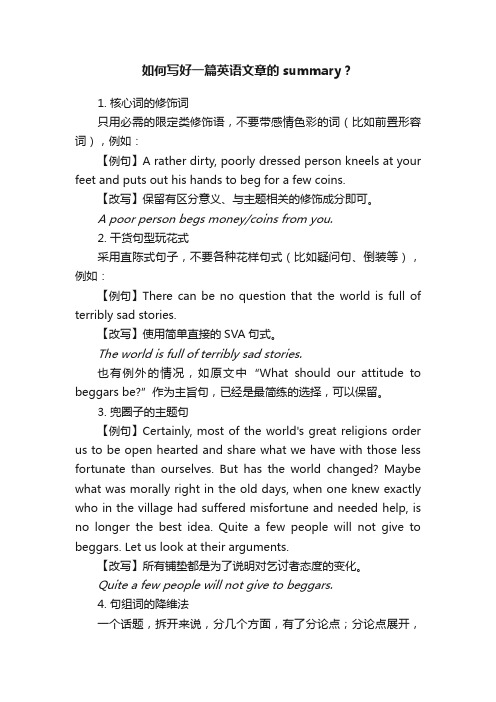
如何写好一篇英语文章的summary?1. 核心词的修饰词只用必需的限定类修饰语,不要带感情色彩的词(比如前置形容词),例如:【例句】A rather dirty, poorly dressed person kneels at your feet and puts out his hands to beg for a few coins.【改写】保留有区分意义、与主题相关的修饰成分即可。
A poor person begs money/coins from you.2. 干货句型玩花式采用直陈式句子,不要各种花样句式(比如疑问句、倒装等),例如:【例句】There can be no question that the world is full of terribly sad stories.【改写】使用简单直接的SVA句式。
The world is full of terribly sad stories.也有例外的情况,如原文中“What should our attitude to beggars be?”作为主旨句,已经是最简练的选择,可以保留。
3. 兜圈子的主题句【例句】Certainly, most of the world's great religions order us to be open hearted and share what we have with those less fortunate than ourselves. But has the world changed? Maybe what was morally right in the old days, when one knew exactly who in the village had suffered misfortune and needed help, is no longer the best idea. Quite a few people will not give to beggars. Let us look at their arguments.【改写】所有铺垫都是为了说明对乞讨者态度的变化。
Summary的写作技巧和常见句型
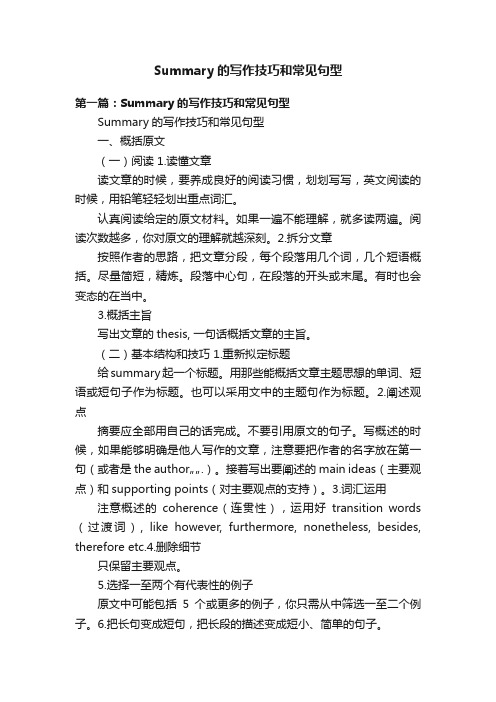
Summary的写作技巧和常见句型第一篇:Summary的写作技巧和常见句型Summary的写作技巧和常见句型一、概括原文(一)阅读 1.读懂文章读文章的时候,要养成良好的阅读习惯,划划写写,英文阅读的时候,用铅笔轻轻划出重点词汇。
认真阅读给定的原文材料。
如果一遍不能理解,就多读两遍。
阅读次数越多,你对原文的理解就越深刻。
2.拆分文章按照作者的思路,把文章分段,每个段落用几个词,几个短语概括。
尽量简短,精炼。
段落中心句,在段落的开头或末尾。
有时也会变态的在当中。
3.概括主旨写出文章的thesis, 一句话概括文章的主旨。
(二)基本结构和技巧 1.重新拟定标题给summary起一个标题。
用那些能概括文章主题思想的单词、短语或短句子作为标题。
也可以采用文中的主题句作为标题。
2.阐述观点摘要应全部用自己的话完成。
不要引用原文的句子。
写概述的时候,如果能够明确是他人写作的文章,注意要把作者的名字放在第一句(或者是the author…….)。
接着写出要阐述的main ideas(主要观点)和supporting points(对主要观点的支持)。
3.词汇运用注意概述的coherence(连贯性),运用好transition words (过渡词), like however, furthermore, nonetheless, besides, therefore etc.4.删除细节只保留主要观点。
5.选择一至两个有代表性的例子原文中可能包括5个或更多的例子,你只需从中筛选一至二个例子。
6.把长句变成短句,把长段的描述变成短小、简单的句子。
“ He was hard up for money and was being pressed by his creditor.” 可以概括为:“He was in financial difficulties.”“His courage in battle might without exaggeration be called lion-like.” 可以概括为:”He was very brave in battle.”“He was hard up for money and was being pressed by his creditor.” 可以概括为:“He was in financial difficulties.”6)你还可以使用词组代替整句或者从句。
英语summary写作技巧
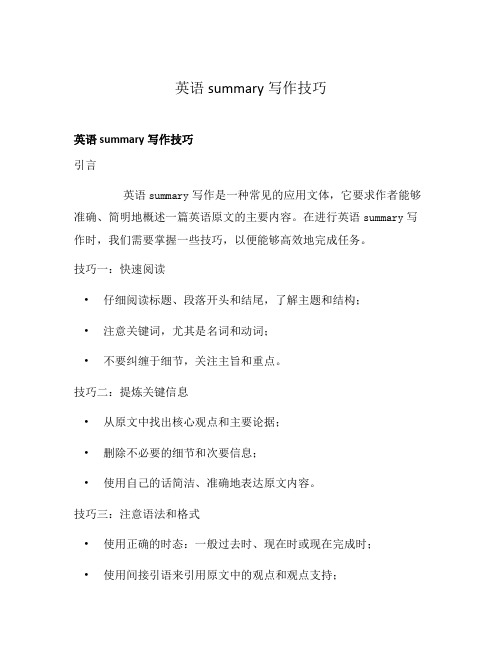
英语summary写作技巧
英语summary写作技巧
引言
英语summary写作是一种常见的应用文体,它要求作者能够准确、简明地概述一篇英语原文的主要内容。
在进行英语summary写作时,我们需要掌握一些技巧,以便能够高效地完成任务。
技巧一:快速阅读
•仔细阅读标题、段落开头和结尾,了解主题和结构;
•注意关键词,尤其是名词和动词;
•不要纠缠于细节,关注主旨和重点。
技巧二:提炼关键信息
•从原文中找出核心观点和主要论据;
•删除不必要的细节和次要信息;
•使用自己的话简洁、准确地表达原文内容。
技巧三:注意语法和格式
•使用正确的时态:一般过去时、现在时或现在完成时;
•使用间接引语来引用原文中的观点和观点支持;
•遵循字数限制,并按照规定的格式进行排版。
技巧四:模板和短语应用
•学习和应用summary写作常用的模板结构;
•学习和运用表示因果关系、递进关系、对比关系等的短语;
•避免直译,使用地道、自然的表达方式。
技巧五:练习和反馈
•阅读和写作是提高英语summary写作能力的关键;
•练习写不同主题和风格的summary,增加熟练度;
•征求他人的反馈,不断改进自己的写作技巧。
总结
英语summary写作需要我们能够快速理解和概括原文的主要内容。
通过快速阅读、关键信息提炼、语法和格式的准确应用、模板和短语的灵活运用以及持续的练习,我们可以不断提高我们的summary 写作技巧。
希望本文所分享的技巧对您能够更好地完成英语summary 写作有所帮助!。
写好summary的技巧

写好summary的技巧作者:龙艳春来源:《广东教育·高中》2010年第05期众所周知,A summary is a short account giving the main points of something longer or detailed. 按近三年的高考评卷要求,摘要部分单独计分,约30 words,满分5分。
要写好Summary,读懂短文内容是切入点。
一、写作技巧首先,这样设想:这篇文章只有你读过,你能否把主要内容用书面形式转告给你的同学或朋友,让他们看后一目了然。
明确了写summary就是这么一回事之后,因限制大约30个词,考生得开门见山,并掌握写summary的具体方法:1. 省略细节、省略解释、省略重复、省略例子;省略开场白(如省去The passage is about.../ The passage tells us.../From the passage.../The author tells...);2. 用概括性词语代替词组。
如表达“事实上”尽量用“actually”,而不用“as a matter of fact”;3. 用分隔符号、分词结构等代替复合句;4. 用最简练的连词,如but,then,thus,yet,for等过渡;5. 将主题句变同义句,用第三人称改为间接引语;6. 尊重作者观点,不含自己建议;7. 适当运用非谓语动词短语、with短语、倒装句型、定语从句等。
另外,写摘要时还要考虑阅读材料的文体:1. 如果阅读材料是记叙文,一般应包括六要素,如某人因何原因在何时何地做了何事,结果如何。
有时不一定有六要素,但“某人做了某事”则是必有的。
2. 如果阅读材料是夹叙夹议,除体现记叙文六要素外,还要加上该故事给你的启示或感悟;3. 如果阅读材料是说明性或描述性短文,考生就必须用概括的文字来说明某种事物或现象的最主要的特征。
4. 如果阅读材料是议论文,考生尽可能客观简要地转述作者的论点和论据等,特别是论点,关键是找主题句。
- 1、下载文档前请自行甄别文档内容的完整性,平台不提供额外的编辑、内容补充、找答案等附加服务。
- 2、"仅部分预览"的文档,不可在线预览部分如存在完整性等问题,可反馈申请退款(可完整预览的文档不适用该条件!)。
- 3、如文档侵犯您的权益,请联系客服反馈,我们会尽快为您处理(人工客服工作时间:9:00-18:30)。
Summary的写作技巧与常见句型一、概括原文(一)阅读1、读懂文章读文章的时候,要养成良好的阅读习惯,划划写写,英文阅读的时候,用铅笔轻轻划出重点词汇。
认真阅读给定的原文材料。
如果一遍不能理解,就多读两遍。
阅读次数越多,您对原文的理解就越深刻。
2、拆分文章按照作者的思路,把文章分段,每个段落用几个词,几个短语概括。
尽量简短,精炼。
段落中心句,在段落的开头或末尾。
有时也会变态的在当中。
3、概括主旨写出文章的thesis, 一句话概括文章的主旨。
(二)基本结构与技巧1、重新拟定标题给summary起一个标题。
用那些能概括文章主题思想的单词、短语或短句子作为标题。
也可以采用文中的主题句作为标题。
2、阐述观点摘要应全部用自己的话完成。
不要引用原文的句子。
写概述的时候,如果能够明确就是她人写作的文章,注意要把作者的名字放在第一句(或者就是the author……、)。
接着写出要阐述的main ideas(主要观点)与supporting points(对主要观点的支持)。
3、词汇运用注意概述的coherence(连贯性),运用好transition words(过渡词), like however, furthermore, nonetheless, besides, therefore etc、4、删除细节只保留主要观点。
5、选择一至两个有代表性的例子原文中可能包括5个或更多的例子,您只需从中筛选一至二个例子。
6、把长句变成短句,把长段的描述变成短小、简单的句子。
“He was hard up for money and was being pressed by his creditor、”可以概括为:“He was in financial difficulties、”“His courage in battle might without exaggeration be called lion-like、”可以概括为:”He was very brave in battle、”“He was hard up for money and was being pressed by his creditor、”可以概括为:“He was in financial difficulties、”6) 您还可以使用词组代替整句或者从句。
请瞧下面的例子:“Beautiful mountains like Mount Tai, Lushan Mountain, and Mount Huang, were visited by only a few people in the past、Today, better wages, holidays with pay, new hotels on these mountains, and better train and bus services, have brought them within reach of many who never thought of visiting them ten years ago、”可以概括为:”Beautiful mountains like Mount Tai, once visited by only a few people, are today accessible to many, thanks to better wages, paid holidays, new hotels and better transportation services、”7) 使用概括性的名词代替具体的词,比如:“She brought home several Chinese and English novels, a few copies of Time and Newsweekand some textbooks、She intended to read all of them during the winter vocation、”可以概括为:”She brought home a lot of books to read during the vocation、”8) 使用最短的连接词。
比如,可以使用but, then, thus, yet, though,不能使用at the same time, in the first place, because of these, on the other hand等较长的连接词。
通常,使用分号就能够达成使用连接词的效果。
9) 文章中的第一人称说的话通常在摘要中转换成第三人称,从而把大段的对白简化,比如: Kate looked at Paul disapprovingly: You use much too much salt on your food, Paul —it’s not good for you!” Paul put down his knife and frowned:”Why on earth not! If you didn’t have salt on your food it would taste awful… like eating cardboard or sand… just imagine bread without salt in it, or potatoes or pasta cooked without salt!” Kate was patient、She didn’t want to quarrel with Paul、She wanted to persuade him、She said firmly:”But too much salt is bad for you、It cause high blood pressure and latter on, heart-attacks、It also disguises the taste of food, the real tastes which are much more subtle than salt, and which we have lost the sensitivity to appreciate any more、”可以用第三人称概括为:Kate suggested to Paul that he should eat less salt、She thought that eating too much salt would do hard to Paul’s hea lth and that it could reduce the real tastes of food、But Paul disagreed、He said that food without salt would be tasteless、7、注意问题(1)避免重复在原文中,为了强调某个主题,可能会重复论证说明。
但就是这在summary中就是不能使用的。
应该删除那些突出强调的重述句。
(2)不要把自己的观点强行添加给作者(3)概述长度不要超过原文章的1/4(4)不要过多照搬原作者的用词,用句(尽可能用自己的话来写,但不排斥用原文的某些词句)。
(5)最后检查一遍,确保文中没有语病,没有语法错误与拼写错误。
二、论文摘要摘要的基本结构与内容因为摘要本质上就就是一篇高度浓缩的论文,所以其构成与论文主体的结构就是对应的。
因此,摘要应包括以下内容梗概:(1)目的:研究工作的前提、目的与任务, 所涉及的主题范围;(2)方法:所用的理论、条件、手段等;(3)结果(4)结果的分析、比较、评价、应用,提出的问题,今后的课题, 假设、启发、建议、预测等;(5)其她:不属于研究、研制、调查的主要目的,但具有重要的信息价值。
(一)引言部分1、回顾研究背景常用词汇有:review, summarize, present, outline, describe等。
This paper outlines some of the basic discusses about……、2、阐明写作或研究目的常用词汇有:purpose, attempt, aim等。
另外还可以用动词不定式充当目的状语来表达。
例如: To investigate the mechanism of……、3、介绍论文的重点内容或研究范围常用的词汇有:study, present, include, focus, emphasize, emphasis, attention等。
Here we study the……、This article includes a brief review of………(二)方法部分1、介绍研究过程常用词汇有:test, study, investigate, examine, experiment, discuss, consider, analyze, analysis等。
We presen t an analysis of ……、2、说明研究或试验方法常用词汇有:measure, estimate, calculate等。
We have developed a……model to estimate ……、、This study presents estimates of……、、(三)结果部分1、展示研究结果常用词汇有:show, result, present等。
We show this cell death to be dependent upon……Our results suggest that……2、介绍结论常用词汇有:summary, introduce, conclude等。
By means of a series of examples, we conclude that……(四)讨论部分1、陈述论文的论点与作者的观点常用词汇有:suggest, report, present, explain, expect, describe等。
The results suggest that……In this study, we describe ……、2、阐明论证常用词汇有:support, provide, indicate, identify, find, demonstrate, confirm, clarify等。
3、推荐与建议常用词汇有:suggest, suggestion, recommend, recommendation, propose, necessity, necessary, expect等。
